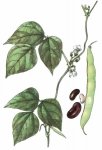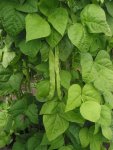Kidney beans
Phaseolus vulgaris L.
Botanical characteristics. Family beans. Annual herbaceous plant with a long curly stalk. Leaves are three-complex. The flowers are collected in short axillary brushes, white or purple. Fruits are pendant smooth beans containing seeds between incomplete spongy septa.
Spread.
Beans come from South America. As leguminous plant is cultivated in the middle and southern regions of our country.
Used parts. Fruits, seeds.
Beans contain carotene - 0.31 mg%, vitamins K - 0.29 mg%, B1 - 0.073 mg%, B2 - 0.14 mg%, PP - 0.50 mg%, pantothenic acid - 0.20 mg%, Vitamin B6 - 0,14mg%, vitamin C - 19.50mg%. Mineral content reaches significant values, 100 g of beans contains sodium - 1.7 mg, potassium - 256.0 mg, magnesium - 26.00 mg, calcium - 50.8 mg, iron - 0.79 mg, phosphorus - 37, 00 mg, iodine 3.0 mg.
Bean fruits contain amino acids arginine, trigonellin, tyrosine, leucine, lysine, tryptophan, choline, asparagine and hemicellulose.
Arginine determines the antidiabetic (hypoglycemic) action of bean pods, similar to the action of insulin.
Application. In scientific medicine is not used. In folk medicine, bean pods are used for diabetes mellitus and chronic pancreatitis. Bean pods are also added to the fees in the treatment of rheumatism, dropsy, kidney diseases.




Comments
When commenting on, remember that the content and tone of your message can hurt the feelings of real people, show respect and tolerance to your interlocutors even if you do not share their opinion, your behavior in the conditions of freedom of expression and anonymity provided by the Internet, changes Not only virtual, but also the real world. All comments are hidden from the index, spam is controlled.